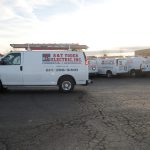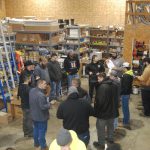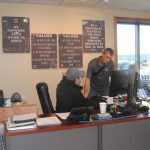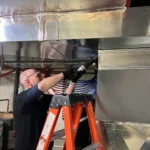When winter arrives, having a functioning furnace is crucial for maintaining a comfortable and safe home. Unfortunately, furnaces can malfunction for various reasons, leaving you in the cold. Understanding how to troubleshoot common furnace issues can save you time, money, and the discomfort of a chilly home. This guide will walk you through the essential steps to troubleshoot your furnace, helping you identify problems and determine whether a heating repair is necessary.
Understanding Your Furnace
Before diving into troubleshooting, it’s important to have a basic understanding of your furnace. Furnaces generally come in two types: gas and electric. Each type has different components and troubleshooting steps, but many issues can affect both.
Common Components of a Furnace
- Thermostat: This device controls the temperature in your home and signals the furnace to turn on or off.
- Burner Assembly (for gas furnaces): This is where gas is ignited to produce heat.
- Heat Exchanger: This component transfers heat from the burner to the air that circulates through your home.
- Blower Motor: The blower motor circulates heated air through the ducts into your home.
- Flue Pipe: This pipe exhausts harmful gases outside your home.
- Filters: Air filters remove dust and debris from the air before it enters the furnace.
Understanding these components can help you identify potential problems during troubleshooting.
Signs Your Furnace Is Malfunctioning
Before you troubleshoot, it’s crucial to recognize the signs that indicate your furnace may not be functioning correctly:
- No Heat: The most obvious sign is when your furnace isn’t producing any heat at all.
- Strange Noises: Unusual sounds like banging, rattling, or squealing can indicate mechanical problems.
- Frequent Cycling: If your furnace turns on and off repeatedly, it could be a sign of an issue.
- Increased Energy Bills: A sudden spike in your energy bill can indicate your furnace is working harder than it should.
- Yellow Burner Flame (for gas furnaces): A healthy flame should be blue. A yellow flame can indicate improper combustion.
Recognizing these signs early can help you address issues before they escalate.
Step-by-Step Furnace Troubleshooting Guide
1. Check the Thermostat
Start with the easiest and most accessible component—your thermostat.
- Ensure It’s Set to Heat: Sometimes, the thermostat may accidentally be set to “cool” or “off.” Ensure it is set to “heat” and that the temperature is set above the current room temperature.
- Replace Batteries: If your thermostat is battery-operated, check the batteries. Low batteries can cause erratic behavior.
- Inspect for Damage: Look for any visible signs of damage or malfunction. If your thermostat is digital, make sure the display is working properly.
- Calibration: If your thermostat is mechanical, consider using a separate thermometer to compare temperatures. If the readings differ significantly, it may be time to recalibrate or replace the thermostat.
2. Inspect the Air Filter
A clogged air filter can restrict airflow, causing your furnace to work harder and potentially leading to overheating and failure.
- Locate the Filter: Typically, the filter is located near the blower compartment or where the return air duct enters the furnace.
- Check the Condition: If the filter looks dirty or clogged, replace it with a new one. It’s recommended to change your filter every 1-3 months, depending on usage and filter type.
- Restart the Furnace: After replacing the filter, turn the furnace back on and see if it operates normally.
3. Examine the Power Supply
If your furnace won’t turn on, it could be a power supply issue.
- Check the Circuit Breaker: Make sure the circuit breaker for the furnace hasn’t tripped. If it has, reset it and try turning the furnace on again.
- Inspect the Power Switch: Some furnaces have a power switch located near the unit. Make sure it is turned on.
- Test the Outlet: If you have an electric furnace, ensure it’s plugged in and that the outlet is working properly.
- Use a Multimeter: If you have the tools and knowledge, you can use a multimeter to check the voltage at the furnace. If there’s no power, further investigation of the electrical supply is needed.
4. Look for Gas Supply Issues (for Gas Furnaces)
If you have a gas furnace, ensure there is gas supply to the unit.
- Check the Gas Valve: Ensure the gas valve is in the “on” position. If it’s closed, open it.
- Inspect the Pilot Light: If your furnace has a pilot light, ensure it is lit. If not, follow the manufacturer’s instructions to relight it. If the pilot light won’t stay lit, it may indicate a more significant issue, such as a faulty thermocouple.
- Listen for Gas Flow: If you can smell gas or hear a hissing noise, evacuate the area immediately and call your gas company.
- Inspect the Flue Pipe: Ensure the flue pipe is not blocked, as this can prevent gases from venting properly and cause safety issues.
5. Examine the Blower Motor
If your furnace is producing heat but not distributing it, the blower motor might be the issue.
- Check for Blockages: Ensure that air ducts and vents are not obstructed by furniture, debris, or dust.
- Inspect the Motor: Look for any visible damage or loose connections. Listen for unusual sounds when the motor operates.
- Reset the Blower: Some models have a reset button on the blower motor. Press it to see if that resolves the issue.
- Check the Capacitor: If the blower motor won’t start, it may be a capacitor issue. A technician can help test and replace the capacitor if necessary.
6. Assess the Heat Exchanger
If your furnace is blowing cold air, the heat exchanger could be the culprit.
- Inspect for Cracks or Damage: A damaged heat exchanger can cause carbon monoxide leaks, which are dangerous. Look for signs of cracks or corrosion.
- Check for Overheating: If your furnace is overheating, it may shut off automatically for safety reasons. Ensure the airflow is not obstructed and that the filter is clean.
- Use a Carbon Monoxide Detector: If you suspect issues with the heat exchanger, ensure you have functioning carbon monoxide detectors in your home to alert you of any dangerous gas leaks.
7. Check the Safety Switches
Furnaces are equipped with safety switches that can shut the unit down if something is wrong.
- Inspect the Door Switch: Most furnaces have a door switch that disables the unit when the access panel is removed. Ensure the door is securely closed.
- Look for Other Safety Switches: Some furnaces have safety switches that monitor airflow or pressure. If these switches are tripped, the furnace may not operate.
- Test Safety Switches: If you suspect a safety switch is malfunctioning, consult your furnace’s manual for testing procedures or consult a professional.
8. Call a Professional
If you’ve gone through the troubleshooting steps and your furnace still isn’t functioning correctly, it may be time to call a heating repair professional. They can conduct a more thorough inspection and repair any complex issues, such as problems with the furnace’s wiring or control board.
- Keep Detailed Notes: When you contact a professional, provide them with detailed notes about the issues you’ve experienced and any troubleshooting steps you’ve already taken. This information can help them diagnose the problem more efficiently.
- Discuss Preventative Maintenance: During the visit, discuss ongoing maintenance options to help prevent future issues.
Preventative Maintenance Tips
To prevent furnace malfunctions in the future, consider these maintenance tips:
- Schedule Annual Inspections: Have a professional inspect your furnace at least once a year, ideally before the winter season begins. Regular inspections can help catch minor issues before they become significant problems.
- Change Filters Regularly: As mentioned earlier, changing your air filter every 1-3 months is crucial for optimal performance. Consider investing in higher-quality filters that may last longer and provide better filtration.
- Keep the Area Around the Furnace Clear: Ensure that the space around your furnace is free from clutter, allowing for proper airflow and maintenance access. Avoid storing items near the furnace that could block airflow or become fire hazards.
- Test Carbon Monoxide Detectors: If you have a gas furnace, make sure you have functioning carbon monoxide detectors in your home. Test them regularly and replace batteries as needed.
Seasonal Preparation
- Prepare for Winter: Before winter hits, check your furnace to ensure it’s ready for the cold months. This includes checking the thermostat, filters, and any visible components for signs of wear or damage.
- Clean Ductwork: Consider having your air ducts cleaned regularly to improve airflow and indoor air quality. Dust and debris in the ducts can reduce efficiency and lead to respiratory issues.
Educate Yourself
- Learn About Your Furnace: Familiarize yourself with your furnace’s user manual. Understanding its features and requirements can help you troubleshoot more effectively.
- Join Online Forums: Many homeowners share their experiences and solutions to common furnace issues on online forums. Joining these communities can provide valuable insights.
Monitor Your Furnace’s Performance
- Keep an Eye on Energy Bills: Regularly monitor your energy bills. A sudden increase may indicate that your furnace is working harder than it should, signaling a need for maintenance or troubleshooting.
- Track Performance Changes: Note any changes in your furnace’s performance, such as longer heating times or inconsistent temperatures. Keeping a log can help you identify patterns and communicate effectively with professionals if needed.
Troubleshooting a malfunctioning furnace can seem daunting, but with a little patience and the right approach, you can often identify and resolve issues on your own. By understanding your furnace’s components, recognizing the signs of malfunction, and following a systematic troubleshooting process, you can save time and money and ensure a warm, comfortable home during the cold winter months. Regular maintenance and preventative measures can further enhance your furnace’s performance and longevity, allowing you to enjoy reliable heat season after season. If you encounter complex issues or feel uncertain about any steps, don’t hesitate to contact a heating repair professional. Your comfort and safety are worth it!







